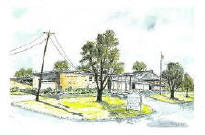 Imagine walking down a dusty pine-shaded path in northwestern Greenville County to a little wooden structure with no running water. For the present students at Duncan Chapel that may sound not so different from going to class in a portable. But now imagine that it is mid-August 1878. You have already been in school for nearly three weeks; there are only two more weeks before the little building will be shut up for the month it takes to pick this year's cotton crop. Your classmates are children of all ages, for your classroom is home to grades one through eight. The day is hot but there are no fans; the only water comes from a spring near the building where you wait your turn to drink from a metal dipper. You buy your own text books--English, arithmetic, geography, and spelling. Probably you and your classmates will receive all the formal instruction you will ever have right here in this room.
Imagine walking down a dusty pine-shaded path in northwestern Greenville County to a little wooden structure with no running water. For the present students at Duncan Chapel that may sound not so different from going to class in a portable. But now imagine that it is mid-August 1878. You have already been in school for nearly three weeks; there are only two more weeks before the little building will be shut up for the month it takes to pick this year's cotton crop. Your classmates are children of all ages, for your classroom is home to grades one through eight. The day is hot but there are no fans; the only water comes from a spring near the building where you wait your turn to drink from a metal dipper. You buy your own text books--English, arithmetic, geography, and spelling. Probably you and your classmates will receive all the formal instruction you will ever have right here in this room.
Mr. J. Ford Thackson, who graduated from the eighth grade at Duncan Chapel in 1919, remembers what we can only imagine. He himself did not attend the first school in the neighborhood, which was built in 1878 on a knoll in what is now Northwood Hills. He began first grade in about 1910, after the school had moved to its second location, right next to Duncan Chapel, a little Methodist church whose cemetery still stands across Old Buncombe Road.
The new Duncan Chapel School was much like its predecessor. Water came from a spring, the building had only one room for eight grades, and the school calendar still reflected the necessity for all able-bodied youngsters to help get the cotton in. Children walked to school along the dirt roads that would become Duncan Chapel and Old Buncombe, but would not be paved for many years.
Sometime after 1910, the little one-room school became too small for the ever-increasing number of students and around 1912 it was abandoned for a brand-new, two story wooden structure built on the site of the present school. This modern facility boasted two classrooms on the first floor, an auditorium on the second, and its own well out behind the building. It was about this time that the teacher, fearing the health hazards of the common dipper, insisted that each child bring a collapsible tin drinking cup.
A photograph taken in 1917 shows 55 students (including Mr. Thackson) and two teachers in front of the unlandscaped, white, wooden-sided structure. Although the building had changed, most things remained the same. Children still bought their own books; a copy of Maury's New Complete Geography cost $.88. Classes still stopped in September for cotton picking, and instruction still went only through eighth grade. For some students, there was the possibility of continuing their education at one of the boarding schools in the district, for instance, North Greenville Baptist Academy (now North Greenville College) in Tigerville. But the cost of higher education was doubly high for farming families of the time. Not only the expense of tuition, room, and board, but the loss of a valued worker made post-elementary school education out of reach for most children. Mr. Thackson himself did go on to boarding school and to many other things, settling eventually in the same neighborhood where he got his start. We are grateful to him for so graciously sharing his memories, his photographs, and his old schoolbooks so that we might get a glimpse of another, very different time.
We would like to thank Debbie Spear for researching and writing the history of Duncan Chapel.